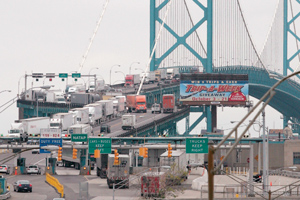Ambassador Bridge — TT File Photo
The city of Windsor, Ontario, said Michigan’s recommendation to allow more hazardous materials to cross the Ambassador Bridge is based on a deficient study that doesn’t consider the 75,000 people in Canada who would be exposed to accident risk.
Windsor’s complaints were contained in a recent eight-page commentary sent to the Michigan Department of Transportation, which recommended in December that such hazmat loads as fuel, paint, gases and acids be allowed to cross, although explosives and radioactive materials would still be banned.
Michigan’s study is “fundamentally deficient because it fails to address or inadequately addresses” such things as response capability of police and fire on both sides of the border and the economic impact if the bridge is damaged in an accident, the commentary said.
“Importantly, estimates based on [Windsor] data which were not considered . . . suggest that proposed changes to . . . allow more classes of [hazmat] will possibly expose up to 75,000 more people in the Windsor area than if the routing is maintained as it is today,” said the commentary, signed by city of Windsor engineer Mario Sonego.


